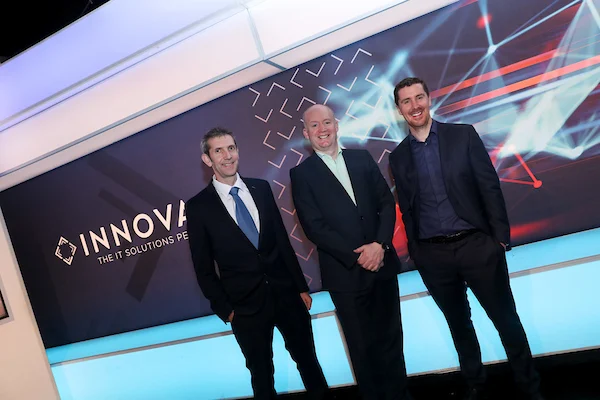
Software defined wide area networks (SD-WANs) offer lower costs, increased security, reduced complexity and improved flexibility. This was the clear message delivered at the launch of the new strategic partnership between Virgin Media Business, Innovate and Cisco which is bringing this entirely new way of managing and operating network and connectivity infrastructure to customers in Ireland.
Speaking at the launch event in Ireland’s largest HDTV studio at Virgin Media TV in Ballymount, Dublin, Virgin Media chief executive Tony Hanway said: “SD-WAN is one of the most exciting and fastest growing network technologies today. The new solution, powered by Cisco, with rapid and resilient connectivity provided by Virgin Media Business and Innovate’s technical expertise, will enable more secure, consistent and cost-effective enterprise connections for our customers.”
Innovate CEO Jim Hughes explained that the SD WAN solution will reduce network costs and improve application performance for mid-size and larger enterprises. This is achieved through a fundamental shift in the traditional wide area network (WAN) paradigm which traditionally saw all network traffic routed internally before connecting to the internet. Using SD RAM, users throughout an organisation can connect securely and speedily to cloud based infrastructure and software-as-a-service applications without the need to first go through the internal WAN.
Those traditional WAN environments encompass a mix of business applications, headquarters networks, branches, datacentres and so on, according to Cisco Head of Technical Strategy Tom Long. “The boundaries are quite well defined”, he added. “You do have internet connections, but they are very well controlled and policed.”
These networks are judged according to their security, route optimisation, cost, and agility, Long continued. “They tend to be extremely secure and quite well route optimised but they are quite expensive – not every organisation can afford one, and they are not agile. They are not flexible and are slow to change.”
One of the key issues with these solutions is that much of the traffic generated within the network is actually destined for the internet yet organisations are routing it across expensive WAN infrastructure before it gets out. This adds cost and reduces agility but there are other drivers at play which are pushing the move to SD-WANs.
Quite simply, the world has moved on. Long explained that organisations are increasingly moving to private datacentres while business applications are now hosted everywhere both on the network and in the cloud. Describing this as “northbound” traffic he said that organisations are now moving to hybrid solutions involving their own datacentres, public infrastructure service providers and multiple software-as-a-service providers.
On the “southbound” or user level, employees are increasingly mobile and need to connect directly to applications and services instead of being routed through the organisation’s network.
“Has the network moved at the same pace?” he asked. “It hasn’t really changed and it’s about time it changed to reflect the new world. SD-WAN is secure, route optimised, cost effective, and agile.”
That need to change is not just a technological issue. Gerard O’Neill, Chairman of Amárach research and data consultancy, looked at the business trends which are driving demand for SD-WAN solutions.
“What’s driving demand is three big wants – managing complexity; managing security; and managing flexibility”, he said. “These are the things that business managers say are the real drivers of demand for technology in their organisations.”
The difference between wants and needs is critically important, O’Neill explained. “One rule applies. People buy want they want so you must sell them what they need. Nobody buys a great product if it’s not what they want, even if it’s what they need. Inventing a great new product which saves people money is no good if what they want to do is save time.”
Businesses want to scale quickly but don’t want to make significant capital investments, he added. “They want to know that when opportunity knocks, they will be ready, willing and able to answer, and that they won’t be left behind by more agile competitors who see the same opportunities. For many businesses, the solution lies in using cloud-based solutions to reduce the marginal cost of growth to a level that avoids expensive investments in fixed costs.”
Security is being challenged by the requirement for employees to be more productive. “Doing that in the wrong way can create enormous business risks”, O’Neill said. “One of the key trends now gathering momentum is the emergence of the virtual workforce: people working collaboratively in teams from different locations, including their homes. Businesses want to grow while navigating avoidable risks, which means using technology to empower employees to drive future growth without risking their employers’ security. Growth in areas like the gig economy is driving demand for flexible solutions. Employers want their employees to be able to access and share tools that improve productivity without increasing spend and while meeting the needs of all stakeholders. This is why services like SD-WAN are so important to what every business wants: future growth.”
Tom Long explained how it achieves this through an analogy with Google Maps. Using a map of Dublin featuring Cisco’s office on North Wall and Virgin Media TV in Ballymount. “You need to get from one to the other and you need a good, fast, reliable roads network to do it – that is the underlay”, he said. “You want to get from A to B by the shortest route timewise and you don’t mind paying tolls. The network controller sits above that setting the optimum path. The route it sets is the overlay – everyone does software defined driving now and a software defined wide area network is very similar.”
He continued the analogy by pointing out how an SD-WAN is constantly taking in data, analysing it, and dynamically rerouting traffic to optimise efficiency. And the transport network used is immaterial. “The Cisco solution is the management layer, the traffic can be carried on the internet, MPLS, or 4G LTE. It is transport agnostic. It finds the optimum route, delivers four times better user experience and a 40% saving over traditional WAN operating expenditure.”
And then came the moment of truth. After a brief prayer to what Long described as the “demo-gods” he set up a live working two site SD-WAN. In a highly impressive demonstration of resilience, agility and route optimisation, the network was configured and up and running in minutes and worked perfectly.
The demonstration was followed by a panel discussion chaired by Annette Soraine, chief commercial officer of Innovate. The panel, which included Enda Cahill, CTO, Innovate, Tom Long, and Noel O’Reilly, Business, Product & Solutions Manager, Virgin Media Business, explored various aspects of the SD-WAN solution.
“Organisations can use legacy solutions and suppliers and don’t have to ditch them when the move to SD-WAN”, said Cahill. “SD-WAN is a forward looking solution that allows organisations realise their IT strategies of where they want to be in five years’ time. It reduces complexity, increases flexibility, adds security, and reduces costs. If you are clear on the strategy you can decide how to approach the project. Starting point is to choose one site and use that as proof of value. Once that is up and running, you can roll the SD-WAN solution out across the full network. You start to get the benefits straight away from the first site.”
Long stressed the flexibility of the solution. “It’s not MPLS or any other transport technology versus SD-WAN. SD-WAN is transport agnostic. It co-exists with existing infrastructure and sits on top of it. In terms of security it uses IPSEC – all organisations are using it. It is tried and tested and reliable and there are no concerns in relation to it.”
Noel O’Reilly explained how the ability to scale the solution on a step by step basis is particularly useful in certain sectors. “Retail organisations can benefit by being able to roll out the solution store by store and set up new stores literally in minutes”, he said. “It’s a completely seamless transition with standardised policies. The configuration is centrally controlled and this greatly reduces risk.”
“The proposition is built around people, process, and technology”, Cahill added. “Virgin Media Business and Cisco bring the technology and Innovate provides the process and the people.”
The software basis of the solution is a particular strength, according to Long. “In the new world of SD-WAN, all the value and intelligence is in the software. The day you purchase is the worst it is going to be. Providers will continue to innovate and update and improve so it only gets better.”
The event concluded with a number of case studies in sectors such as hospitality and oil and gas which demonstrated the benefits of SD-WAN solutions including reduced connectivity costs from as high as €4,000 per month to just €350.
“Our objective is to improve the end user experience”, said Jim Hughes of the new partnership. “The strategy is to create a unique value proposition through a single provider of SD-WAN solutions for the Irish market.”
“Virgin Media Business has enjoyed double digit growth over the past few years and there is a heck of a lot more growth out there”, Tony Hanway concluded. “We believe too many people are paying far too much for too little when it comes to service. We are very excited by this new strategic partnership which brings together our superfast network, Innovation’s customer service offering, and Cisco’s leading edge technology. There is a long way to go, but we are very excited about what’s coming down the line.”



